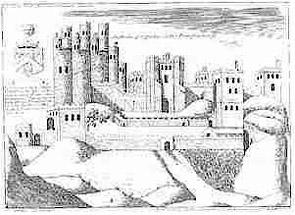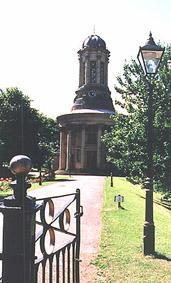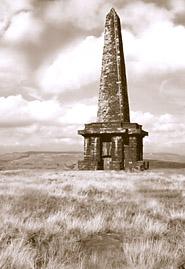FEBRUARY 2002
Richard II, as every schoolboy certainly does not know nowadays, became King of England in 1377 at the age of ten. Though he suppressed the Peasants’ Revolt when only fourteen, things went horribly wrong and Henry Bolingbroke (Henry IV) landed in Yorkshire and removed him from the throne in 1399. History’s official line is that he was imprisoned in Pontefract Castle where he died in 1400 probably of starvation on the orders of the new King. Henry arranged for Richard’s body to be brought south from Yorkshire to prove he was dead.
| But rumours persisted that the body was not that of Richard, that he was not dead but had escaped to Scotland. A man in Stirling claimed to be Richard. Though effectively a prisoner he was entertained royally by the Duke of Albany. He died in 1419 and was buried with pomp and ceremony as Richard II, King of England, by the High Altar of Black Friars. Archaeologists, according to the Times, have found the site under a pedestrian shopping precinct (that just about sums up the advance of civilisation over six hundred years) and hope to locate the High Altar so that they can perform DNA tests on the remains buried there. That should then finally determine whether Richard, the last of the Plantagenets, is buried there or in London. |
Old Drawing of Pontefract Castle |
The crucial evidence will be any DNA link between the remains and those of the Black Prince, Richard’s father and hero of Crecy and Poitiers, who is buried in Canterbury Cathedral. The Black Prince’s statue presides over City Square in Leeds.
It’s a pity children aren’t taught proper history any more. Ours is a wonderful story. One understands the present so much better if one has a proper understanding of the past.
There’s barely anything left of Pontefract Castle now. Originally built by the Normans, it was progressively expanded until it became a seven acre site surrounded by a ditch and a wall, defended by five towers and with a barbican, a drawbridge and a keep. Edward IV stayed there on the eve of the Battle of Towton and Henry VIII, Elizabeth I and Charles I all enjoyed the castle’s hospitality. But it will always be chiefly remembered as the place where Richard II was murdered. ‘O Pomfret, Pomfret! O thou bloody prison’ says one of Shakespeare’s characters.
I recently discovered why our unit of currency is called the pound. It is because 240 silver pennies weighed a pound, a weight used since Roman times. The Saxons called the silver pennies of their Norman conquerors ‘sterlings’ or ‘starlings’ perhaps because some early Norman pennies had a little star stamped on one side. When amounts were paid into the Norman government’s exchequer the coins were weighed to ensure that all were genuine and complete. 240 pure coins weighed a pound. Pound is from the Latin pondo. 240 old pennies (d) made up one pound sterling until 1971 when the pound was decimalised (p). (Incidentally, a euro is a type of kangaroo).
|
Saltaire Church |
Like Fountains Abbey, though
of a rather different nature, the industrial buildings and adjoining village
of Saltaire, near Bradford (see both in Places), has been made a World
Heritage Site. Built by Titus Salt, closed in 1986 and restored by the late
Jonathan Silver, these factories are now recognised for their architectural
and social significance. If I were put blindfold into Salt’s Mill I would know
where I was from the smell, presumably of oil and wool though, I also like to
think, of sweat and toil which characterises the place. It is well worth a
visit. It is the industrial West Riding. Or rather what used to be the
industrial West Riding. Stoodley Pike, near Mankinholes - what a splendid name - dominates the skyline between Hebden Bridge and Todmorden in the Pennines west of Halifax. It is a stone obelisk 120 feet high and was originally built in 1814 to commemorate the surrender of Paris to the Allies. Construction was suspended after Napoleon escaped from Elba but it was completed after the Battle of Waterloo. |
It was struck by lightning and fell down at the moment war was declared on Russia in 1854. The present monument was built by James Green in 1856. Since then it has been used sometimes as a beacon but most of the time just stands in lonely isolation. Inside one can climb a dark winding staircase, avoiding the dead birds and occasional dead sheep, and view the surrounding landscape from the gallery.
| Interested to learn more about Todmorden on Yorkshire’s western frontier, I looked it up on the internet and found information on the Knowhere Guide. The writer, I fear, only reinforced the view that the sophisticated metropolitans of Halifax have about the place. It definitely, he says, has a Royston Vasey feel about it. For years the Todmorden Triangle has been famous among UFO devotees as the location of a series of alien abductions. (I’m not making this up). He continues: ‘Last year someone broke into the town’s aquarium and left a giant fish in one of the tanks. A newspaper headline I remember from the early nineties is ‘Boy throws stone at duck’’. |
|
From the Sunday Telegraph: ‘Police investigating the theft of an Amazon parrot from a house in Ross-on-Wye, Herefordshire, say the bird will be easily identifiable because it speaks with a broad Yorkshire accent’.



 Stoodley Pike
Stoodley Pike